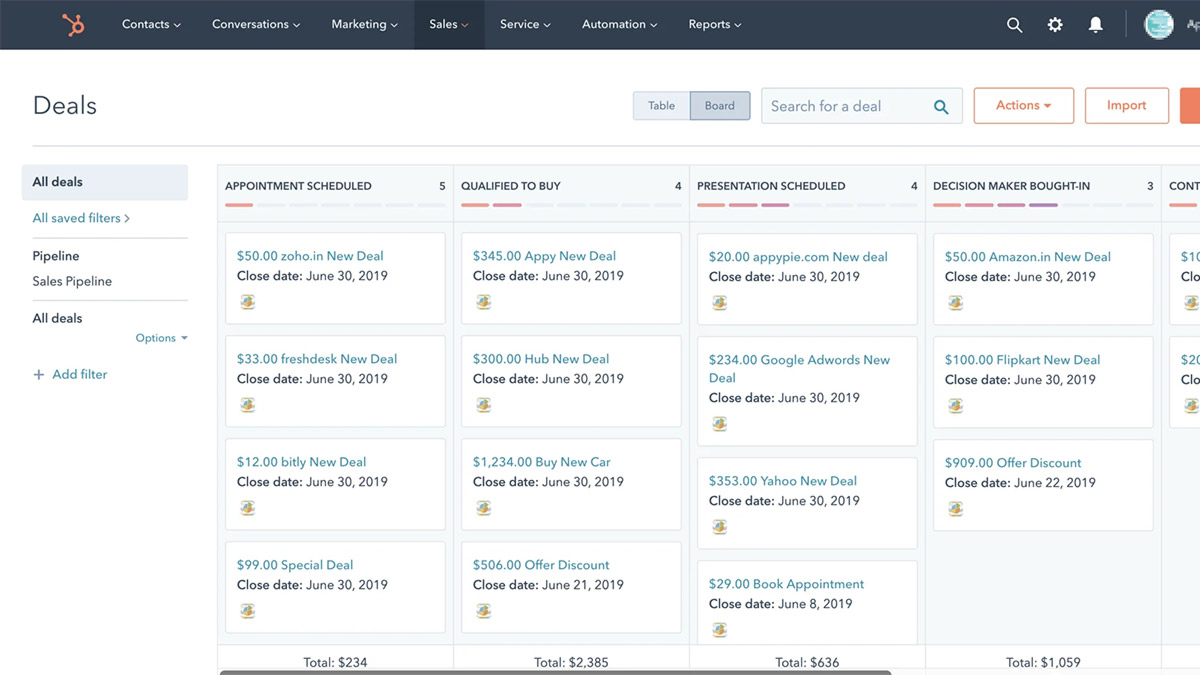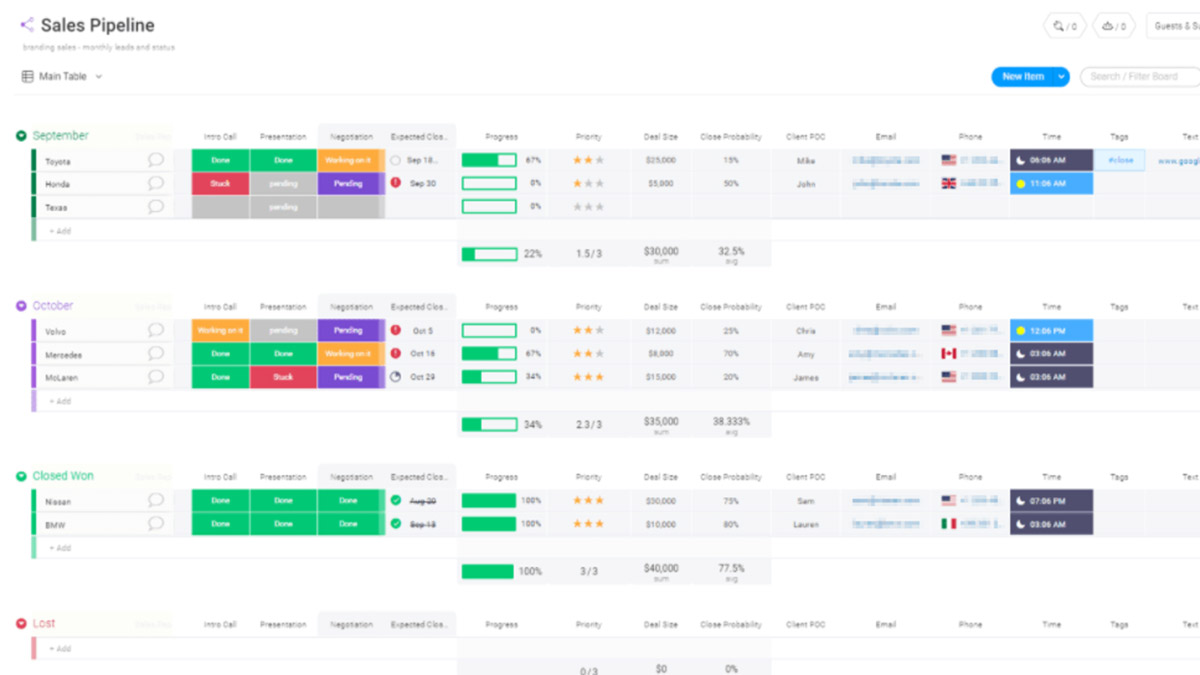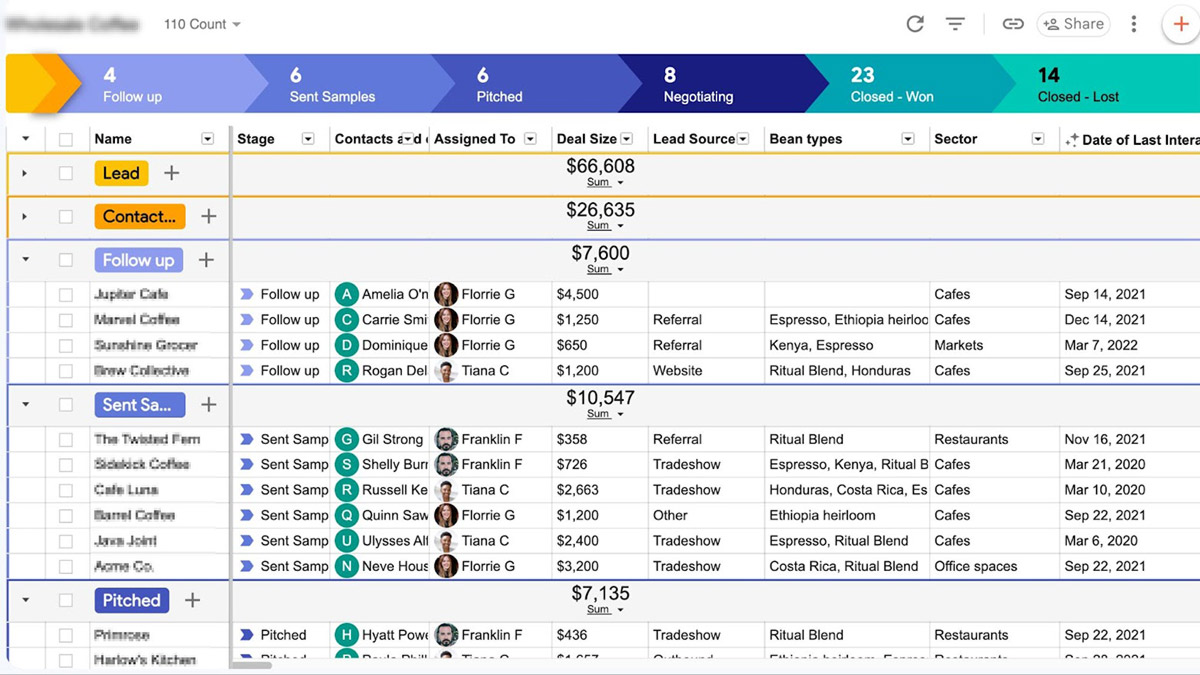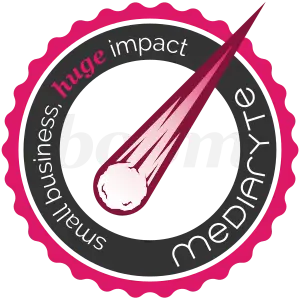
Overview: Here are the top 3 cost-effective CRM Apps for small business lead and customer management. Learn to manage your sales pipeline and qualify your leads.
November 26, 2023
:
Chris Risse
:
22 minutes
:
Affiliate Disclosure
The next step in your small business is unlocking the power of a CRM to help you maximize your sales, marketing, communications and support of your customers and clients. However, this can be a daunting step to take and a misstep you do not want to make.
Too many times have I started with a CRM for my small business only to run into problems later on simply because I did not properly plan my sales pipeline, phases, and my goals for using a CRM. To help you avoid this pain and start running with your own small business CRM, I have prepared a detailed article below that covers everything I have learned and wish I knew when getting started. In the last section, I have included my top 3 cost-effective CRM apps for small business, which come from countless hours of exploring, testing, and working with clients.
Quick Links
What is a CRM?
Just in case you were wondering, a contact relationship manager (CRM) is an application that helps small businesses manage their interactions and relationships with customers and prospects. The CRM stores and tracks important customer information such as names, contact details, purchase history, and communication history, giving small businesses greater insight into their sales processes. In return, a CRM enables businesses to streamline their sales, marketing, and customer support by providing a centralized database for all customer-related information. It allows businesses to better understand and cater to their customers' needs, improve customer satisfaction, and drive revenue growth.
Choosing can be hard, especially when you need a solid solution quickly.
I've made a list of my top 3 CRM apps for small business in the section below.
How to start using a CRM
A CRM isn't a replacement for your personal address book or contact list, but should be considered a layer on top, which allows you to dynamically view and use your contacts in more valuable ways for your small business.
Your address book and contact list are great places to start when adding a CRM to your small business. These resources already have your contact information readily available and organized. Other sources for contact data can be bookkeeping and accounting software, sales management tools, website forms, email lists, and so forth. It isn't necessary to have all fields filled for all contacts, as this is only a starting point.
Common contact fields your CRM will need
Here is a short list of common contact fields you can prepare for importing into a CRM:
- First Name
- Last Name
- Company/Organization
- Email (Single or Multiple)
- Phone (Single or Multiple)
- Address (Address line 1, Address line 2, City, State, ZIP)
Better yet, if your address book or other software with contact data allows you to export the data, then much of this work is already done for you. You will simply want to make sure the exported file is in a CSV or XLS/XLSX file format, so it can easily be imported into the CRM.
It is also worth noting that many modern CRMs will integrate with existing solutions, allowing you to sync contact data across software.
Managing Leads & Customers With A CRM
Now that you understand the intended purpose of a CRM and are able to get your existing contact/customer data imported, let's take a deeper look at how you can effectively use a CRM is your small business:
Centralized Data
A CRM provides a centralized database for storing and organizing lead and contact information. This makes it easier to access and update important details such as contact information, interaction history, purchase behavior, and additional notes. This information can then be utilized by team members and other third-party tools.Efficient Lead Management
With a CRM, you can efficiently manage and track leads throughout the entire sales process. This includes capturing leads, assigning them to appropriate sales representatives, and tracking their progress. It helps prioritize leads, identify potential opportunities, and prevent leads from falling through the cracks.Improved Communication
A CRM allows for effective communication with leads and contacts. It helps automate, track, and manage interactions through various communication channels like emails, phone calls, and social media. This ensures timely and consistent communication, leading to better customer relationships.Personalized Customer Experience
CRM enables businesses to gather and analyze valuable customer data. This data helps in understanding customer preferences, needs, and behaviors. With this knowledge, businesses can personalize their interactions, tailor their offerings, and deliver a better customer experience.Sales and Pipeline Management
A CRM system provides a visual representation of the sales pipeline and tracks the progress of leads at each stage. It helps sales teams prioritize leads, forecast sales revenue, and identify areas for improvement. This increases sales productivity, efficiency, and overall revenue generation.Collaboration and Teamwork
A CRM facilitates collaboration among team members by allowing them to share important lead and contact information. It eliminates silos, improves coordination, and enables better teamwork across different departments, such as sales, marketing, and customer support.This all sounds amazing for your marketing, sales, and communication efforts, but keep in mind that a CRM is only as reliable and valuable as the information that it stores. You must actively use it, by keeping contact data up-to-date and moving contacts through your sales funnel.

A CRM can be a lot of things, but it needs to be a great CRM before anything else.
How To Prepare A CRM Sales Pipeline
If you have never worked with a sales pipeline before, fear not. It is really a simple concept that helps you understand your sales process broken down into parts. The sales pipeline is a series of phases that move a lead along to a conversion, with action steps along the way. If you have not experienced working with a sales pipeline, then it is best to start with basic or default phases that can be updated and customized as you gain experience with selling. Here are the steps to adopt a sales pipeline into your small business CRM:
Define Your Sales Phases
Start by defining the stages or phases that your leads go through in the sales process. This can vary depending on your business, but common stages may include:- Prospecting
- Qualification
- Proposals/Quotes
- Negotiation
- Closed-Won
- Passed
- Referred Out
Configure Your CRM
Set up the CRM system to match your defined sales phases. Most CRM systems allow you to customize the phases and labels to align with your sales pipeline or allow you to create new custom sales pipelines.Assign Default Sales Pipeline
Determine the default sales pipeline for leads. This is the initial pipeline that a lead will enter when they are first added to your CRM system. It could be a general sales pipeline used for all lead sources or specific pipelines based on different marketing campaigns or lead sources. Example: New contacts may enter a Nurturing sales pipeline, while active leads may enter your Opportunity sales pipeline.Assign Leads to Appropriate Stages
When a lead enters your CRM system, assign them to the appropriate stage in the sales pipeline based on their level of interest or engagement. This can be done manually or automatically based on predefined rules, such as lead scoring or specific actions they have taken. Sometimes, it can be difficult to process leads quickly, that is why I suggest an "Inbox" as the initial phase of your sale pipeline. Any leads in this stage can be processed at a later time.Move Leads Through the Sales Pipeline
As leads progress through the sales process, update their phase in the CRM system accordingly. This can be done manually by the sales team or automatically based on predefined criteria, such as completing certain actions, completing a prequalifying process, or reaching a specific lead score.Set Up Deal Management
If pertinent to your small business sales, when a lead is qualified and moves into the "Proposals/Quotes" or "Negotiation" stage, create a deal, job, or estimate in the CRM system. Add relevant details about the opportunity, including expected revenue, close date, and any associated contacts or companies.At this point, your CRM is ready to go. Over time, your CRM will include new contacts and details about the relationships you have with your clients and customers. You may even discover commonalities across your contacts that may allow for improvements to marketing targets, communication styles, and new products and services.
Qualifying Leads In A CRM
Qualifying a lead is the exercise of determining if a potential customer fits the ideal model you have for the type of the customer you want to sell your product or services to. This can be anything from the lead being in the right region or location to the lead being able to afford your services. Identifying this information ahead of time can prevent wasted time and money, but also increase the likelihood of the lead converting. Here are some steps to qualifying your leads in your CRM:
Define Lead Qualification Criteria
Start by defining the specific criteria that you consider as indicators of a qualified lead. This can include characteristics like industry, company size, budget, decision-making authority, or any other factors relevant to your business.Capture Relevant Information
Ensure that your CRM system includes fields to capture the necessary information for lead qualification. This may include demographic data, firmographics, lead source, or any custom fields you need to collect the required information for qualifying leads.Score & Segment Leads
Implement a lead scoring system within your CRM to assign a numerical value or score to each lead based on their attributes, actions, and engagement with your marketing efforts. Assign higher scores to leads that meet your qualification criteria. Use the CRM's segmentation capabilities to group leads based on their attributes or behaviors. This allows you to target specific segments with tailored marketing campaigns or lead nurturing strategies.Monitor Lead Activity
Keep track of the lead's engagement with your marketing materials, such as email opens, clicks, website visits, or content downloads. By monitoring their activity within the CRM, you can gain insights into their level of interest and engagement.Automatic & Manual Qualifying
Utilize automation features in your small business CRM to automatically update the qualification status of leads based on their actions or predefined criteria. For example, if a lead meets certain conditions, such as reaching a specific lead score or completing a particular action, they can be automatically moved to a qualified status. While automation is helpful, some leads may require manual review by your sales or marketing team. Allow the flexibility for your team to review leads individually and adjust their qualification status manually if needed.
All the cool small business dogs keep their CRMs up-to-date and nice and tidy.
Small Business CRM Workflow For Sales
Now that we have all of the concepts out of the way, let's start putting it all into action. Here is a general step-by-step workflow for CRM management for sales.
- Set up lead capture forms on your website or landing pages to collect contact information from potential leads. Google Forms can be a great starting place. If you have a WordPress website, I highly recommend Gravity Forms.
- Ensure that the form integrates with your CRM system, so leads are automatically added to the database. An alternative is to have forms send email notifications to your CRM.
This workflow is a repeatable process your sales team can adapt to begin managing leads coming into your small business. As a reminder, leads may not go through every step, but at least your leads need to go through the first step in order to capture, keep, and maintain their data. Every subsequent step in the workflow is only necessary if it of value to your small business sales process.
Maximizing The Value Of Your CRM
Here are a few more points to be made about continued management of your small business CRM to increase its value and effectiveness:
Keep Contact Information Updated
Contact information is constantly changing and people change roles and move in and out of areas. Through consistent communication, you will know when these changes occur, so keep your contact information as updated as possible to avoid losing communication with your contacts over time.Monitor and Track
Regularly monitor the progress of leads and deals within the sales funnel. Use the CRM system's reporting features to gain insights into conversion rates, deal velocity, or any bottlenecks in the sales process. Being able to see data, such as time-to-conversion, can help you improve your negotiating and nurturing processes.Take Advantage Of Integrations
Many CRMs offer an API service that allows for the integration with third-party applications. This means that your contact data can be shared with other software for purposes, such as email marketing, targeted digital ads, personalized website user experiences, and bookkeeping/accounting needs. You can even utilize a customer view funnel in your CRM to grow your online reviews.Continuous Optimization
Your sales and marketing will evolve with this new insight that the CRM has provided you. Analyze the data to identify areas for improvement. Adjust your sales process, marketing efforts, or lead nurturing strategies accordingly to optimize the sales funnel and improve conversion rates.Again, I must reiterate that a CRM is only as good as the data you put into it. Continuous use and updating, making adjustments and improvements as you go, and consistent communication will make your CRM a valuable asset of your small business.
Top 3 CRM Apps For Small Business
So, why am I recommending these 3 CRM apps for small business? It really comes down to the ease-of-use, cost-effectiveness, and the sheer level of frustration felt when working with a small business CRM - in this case, low levels of frustration. I am very aware of and have used other titan applications in the CRM industry, but these 3 have delivered the best results for myself and many of my small business clients. Here they are in order:
Hubspot

Hubspot is a full suite of powerful sales and marketing tools. If you have a team of sales representatives who are actively engaging leads and a separate marketing team keeping new leads coming in, Hubspot is my recommendation for your small business CRM. Hubspot also has many integrations with third-party applications, as well as website tracking tools.
Monday

Monday offers a customizable CRM for managing your small business contacts and leads. The CRM has many alternative views for managing your sales pipeline. This is very helpful for sales representatives who may need new ways of looking at the sales pipeline to work effectively. In addition, Monday has additional software for creating custom helpdesks, project managers, and client or vendor accounts. All items can be related and connected with third-party applications.
Streak

Streak is another CRM tool for managing a sales pipeline from your Gmail inbox, as well as a standalone app, with many additional capabilities for managing a service tickets, projects, and more. This can be a great CRM for a solo business owner, who has processed in place and wants to keep all communications organized. Streak can also integrate with other third-party applications via the API.
Helpful Resources For Small Business CRMs
Feedback from Clients – A Detailed Guide to Gathering, Analyzing, and Using Feedback
Learn how to collect, respond to, and use feedback from clients to improve service, build loyalty, and grow your business effectively.6 Simple Ways You Can Generate Great Customer Reviews
Your small business can generate great customer reviews just by applying these 6 simple concepts within your daily tasks.Emotional Intelligence Advantage: Crafting Review Responses That Wow Customers
Unleash the power of emotional intelligence to transform customer reviews into opportunities for growth, satisfaction, and business success.Google Business Profile: 11 Powerful Tips For Home Services Pros To Attract Customers
Your Google Business Profile is one of the best ways to be seen by new customers. Optimize your profile, post relevant content, gain customer reviews, and more.How To Create A Great Customer Satisfaction Survey With 5 Examples
A customer satisfaction survey is a powerful tool to gain feedback and more about your small business products and services.About The Author

Chris Risse
Chris is the owner of Mediaryte, a digital commerce company working with local small businesses. He has worked with countless business owners on business mastery, systematizing processes, and quantifying results. Chris also is a competitive fat bike racer and has a fantastic sixth sense for detecting well hidden candy and treats.
